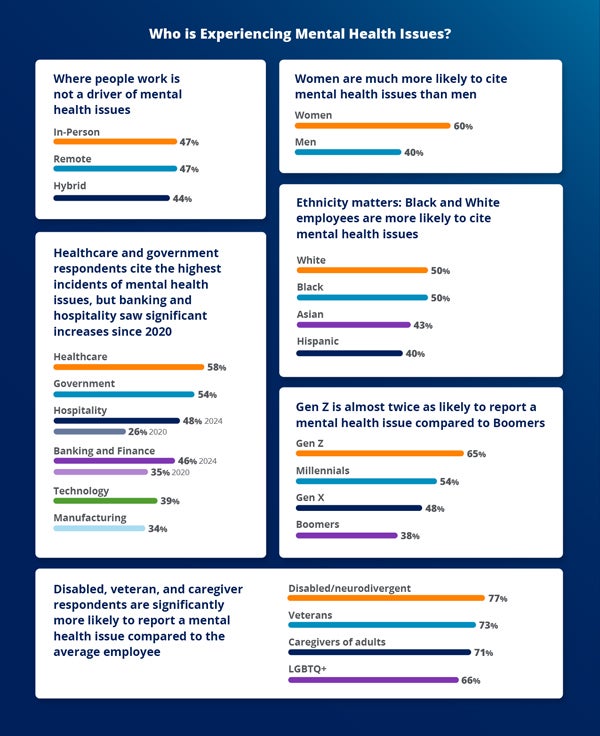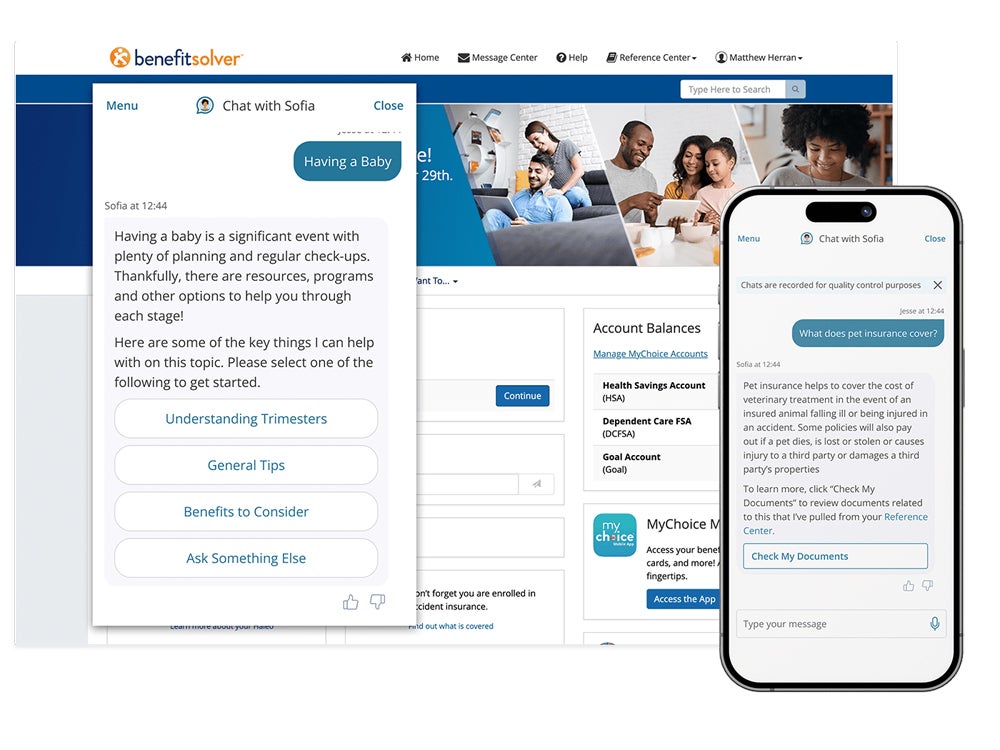Businessolver’s 2024 State of Workplace Empathy Study, which surveyed more than 3,000 CEOs, HR professionals, and employees, paints a concerning picture: mental health is declining sharply among some employee segments.
Overall, 55% of CEOs and 50% of employees cited a mental health issue in the past year, with Gen Z (65%), women (60%), LGBTQ+ (66%), caregivers (71%), veterans (73%), and disabled or neurodivergent (77%) employees especially prone to mental health issues. Notably, CEOs’ self-reported mental health issues jumped 24 points over 2023, shattering myths of invulnerable corporate leaders.
Figure A

Figure B

This year’s survey revealed additional surprises. For one, more CEOs than employees view their company’s culture as toxic, to the tune of 52% and 35%, respectively. Sixty-five percent of CEOs also report feeling intimidated by coworkers, up 17 points over 2023. The study also found a strong link between mental health issues and workplace toxicity: respondents who stated their workplace is toxic were 47% more likely to cite mental health issues.
There are many factors beyond the reach of HR teams that contribute to mental health, but a toxic work environment prevents any efforts they may take toward building a culture of empathy from flourishing. The good news is, toxicity can be mitigated with some practical—and empathetic—HR strategies to promote a healthy and supportive workplace culture.
The antidote to toxicity: empathy
Toxic workplaces can take many forms, but ultimately, there is a near-universal remedy—empathy. At its core, empathy is about understanding and sharing the feelings of others, and Businessolver’s research shows it has a powerful effect on how employees at all levels experience their jobs.
In 2023, 80% of respondents said they would be willing to leave their jobs to find more empathetic employers. Just a year later, in 2024, an even higher percentage (88%) said they would be willing to stay with an employer that empathized with their needs.
The importance of empathy extends beyond fostering a positive work atmosphere. Empathetic workplaces benefit from:
- Increased employee retention.
- Higher productivity.
- Improved overall well-being.
When leaders and colleagues demonstrate empathy, it fosters a sense of trust and psychological safety. Team members and leaders alike feel comfortable expressing concerns, seeking help, and admitting mistakes.
Open communication allows for early intervention when stress or mental health issues arise, preventing problems from escalating and fostering a more supportive and collaborative work environment. In fact, there’s near 90% agreement across employees, HR professionals, and CEOs that it’s important for senior leadership to openly discuss mental health issues to foster a safe environment that encourages others to do the same.
How to build a more empathetic workplace
The data paints a clear picture: empathy in the workplace needs a significant boost. This work begins with the foundational goal of fostering an organizational culture of open communication and understanding, particularly in light of the state of mental health in the workplace.
From the strong groundwork of empathy, there are actionable steps HR teams can take to build a work environment where everyone feels empowered to care for their mental health.
Destigmatize mental health
Particularly in the workplace, mental health issues remain shrouded in stigma. This is especially pronounced among CEOs, 81% of whom said companies view someone with mental health issues as weak or a burden.
Opening a dialogue about mental health can be incredibly beneficial, particularly when the message flows down from the top. Leaders can champion these discussions by sharing their own personal experiences or participating in employer-sponsored educational sessions.
“Leadership plays a vital role in breaking down the stigma of mental illness that our data shows still thrives among American workers,” said Rae Shanahan, Chief Strategy Officer at Businessolver. “I’ve been open about my lifelong mental health journey within the walls of Businessolver and publicly. Mental health does not discriminate—it is widespread and underreported.”
Offer the benefits employees want
The top benefits and resources employees say help them care for their mental health include:
- Open door policies (91%).
- Mental health benefits offered at enrollment (90%).
- Employee assistance programs (89%).
- Flexible working hours (89%).
- Access to online mental health resources or clinics (89%).
- Encouragement to take breaks away from work (88%).
Improve easy access to benefits information
An overwhelming number of employees (90%) said mental health benefits offered during annual enrollment are important. Yet, just 35% reported being aware that such benefits were offered to them. Even more pertinent, only 10% reported using a mental health benefit.
Why is there such a disconnect? After enrollment, it can be difficult for employees to remember exactly what’s included in their benefits plans, and the thought of combing through plan documents to find answers is overwhelming in some cases. This is where powerful but user-friendly tools, like virtual benefits assistants, can be game-changing.
For example, Sofia, Businessolver’s AI-powered benefits assistant, is available 24/7 to respond to employee questions with human-like empathy. Not only does this tool provide access to the information employees need at the precise moment they need it, thereby making it easier for them to actually use their benefits, but it also reduces the administrative burden that often falls on the HR staff’s shoulders.
Figure C

Train managers to be empathetic leaders
Equip managers with the skills to recognize signs of stress and burnout in their teams and encourage open communication and support. Couple this with an intentional employee wellness program—which can begin simply with lunch-and-learn sessions or an employee wellness committee—and the positive power of empathy will soon ripple throughout the entire organization.
The reported decline in workplace mental health is concerning, as untreated mental health can have a significant impact not just on the morale and performance of an organization, but also on the well-being of families and communities. For these reasons, the challenge is a critical one, but not insurmountable. In fact, small gestures of empathy can be very powerful. By prioritizing them now, organizations can create a thriving and resilient workforce for the future.
Marcy Klipfel is the chief engagement officer at Businessolver. See the results of its 2024 State of Workplace Empathy survey at businessolver.com.

